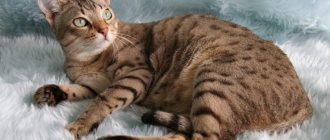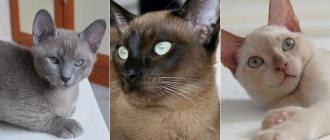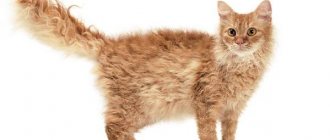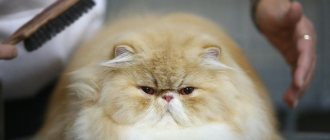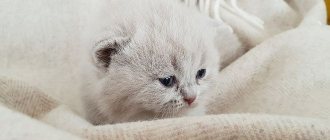There are currently about 600 million domestic cats living in the world. And less than one percent of them are considered purebred. Some varieties of cats are so unusual and unique that their cost can reach several hundred, thousand and tens of thousands of dollars.
Photo: pixabay.com
Various breeds have appeared as a result of long breeding work or random genetic mutations. There are animal hybrids that emerged from crossing domestic cats with various species of wild cats. A breed acquires official status when it is registered and recognized by one of the felinological organizations.
The cost of a particular breed can be influenced by several factors:
- Rarity of representatives.
The rarer a breed is, the more valuable and expensive it is. - Class of purebred kittens.
Felinologists have defined three classes for purebred pets:
Pet
- a pet without breeding rights, with the lowest cost. - Breeding
- with the right to breed, its price increases significantly. - Show class
- meets all breed standards, intended for exhibition work. The most expensive.
Breed traits that are not found in most other cats.
Rating:
- Savannah
- Chausie
- Safari
- Khao-mani
- Toyger
- Bengal cat
- Peterbald
- American Curl
- Elf
- Serengeti
- Manx
- Russian blue
Keeping a Himalayan cat at home
The breed is suitable for home keeping. A calm disposition and playful character will make you a great friend. Suitable for families who spend a lot of time at home, as they do not like being alone. It must be taken into account that the animal is afraid of closed spaces, so you should not lock it in a small room.
The disadvantages include the presence of long hair, but with proper care it will not cause problems.
Care and hygiene
The pet requires certain care:
- Thorough brushing 2-3 times a week (the breed is characterized by constant shedding).
- Daily eye washing (like Persians, Himalayans often “cry”).
Himalayan cat
needs to be bathed at least once every six months. An important part of care is proper nutrition. For especially long-haired representatives of the breed, it is necessary to periodically give special medications that remove accumulated hair from the stomach.
Be sure to read:
Description of the Chinchilla cat breed - character, habits, hygiene and grooming of this beauty
Diet of the Himalayan cat
Himalayan cats and male cats that are prone to obesity should not be overfed. It is necessary to control the amount of food eaten per day, especially if you already have problems with excess weight. Feeding should be done twice a day. Basic food: meat (beef, occasionally sea fish) and fermented milk dishes (cottage cheese, kefir).
It is preferable to give ready-made dry/wet food, preferably premium food. Proper nutrition will also help prevent breed-specific health problems.
Diseases and breed defects
Himalayan cat
The Himalayan cat is in good health, but there are hereditary predispositions and the risk of acquiring congenital diseases. The most common hereditary disease is polycystic kidney disease.
Like Persians, Himalayans are particularly susceptible to respiratory diseases, often having difficulty breathing due to their flattened nose. Problems with the eyes, skin, and liver may occur.
Education and training
It is believed that the breed is difficult to train, but purebred kittens quickly learn the rules of behavior. Training is also possible, but only if the animal shows interest and ability in it. So, it will be difficult to make a cat with small paws jump high, but they will be able to ask for food while sitting on their hind legs.
The sooner you start training, the better the result will be.
Castration and sterilization
If there is no goal of getting offspring from a cat, it is better to sterilize the animal. With regular estrus and avoidance of mating, the cat can get sick (even oncology). Males are castrated to prevent them from marking territory.
The difference between castration and sterilization: in the first case, the cat's testicles / ovaries are surgically cut off (with or without the uterus), in the second, the seminal ducts / fallopian tubes are ligated. Sterilization is a more gentle procedure and is optimal for the pet.
Top 10 hypoallergenic cats
There are 10 species of representatives of the cat family that emit the least amount of allergens. Hypoallergenic cats from this list are much more expensive than purebred pets, but in this case a person pays for the safety of his body’s health.
The Balenesian hypoallergenic cat is one of the varieties of Siamese cats that have longer hair. It is considered one of the most popular cat breeds from which there is no allergy.
Representatives of this species stand out for their gracefulness, smooth movements and bends. They are kind and sociable, thanks to which they quickly find a common language with new people and animals. The Balinese cat leads a passive lifestyle and does not conflict with its owners.
Oriental shorthaired hypoallergenic cats first appeared in Thailand. However, American breeders brought fame to this breed. These hypoallergenic pets are distinguished by their kindness, flexible and affectionate nature.
Oriental kittens quickly get used to their new owners and cease to be afraid of them. It is considered a safe cat breed in terms of releasing allergens.
The Javanese is an American shorthaired breed that causes virtually no allergic reactions in humans. In addition to the fact that the fur of these pets is hypoallergenic, it can vary significantly in color and thereby amaze future owners when choosing a kitten.
Siberian cats are pets of a truly Russian breed. They can cause allergies in people only in 20–25% of cases. From this point of view, Siberian cats break stereotypes.
It is worth paying special attention to the hair of these hypoallergenic animals. They have very long, thick and silky fur, which protects them from frost.
Allerka is a beautiful cat, but at the same time very expensive. The amount of enzymes that can cause allergies was artificially reduced during a long-term selection process.
At the moment, Allerka are the most hypoallergenic cats in the world, as their safety for allergy sufferers has been scientifically proven.
A hypoallergenic allerka cat will become not just a safe hypoallergenic animal, but also an affectionate animal for its owners.
Description, lifestyle and habitat in the wild
The black-footed cat has fur of a rich sandy-yellow color, strewn with medium-sized black spots that can join into small stripes. The animal’s paws are strong and colored black, which is how this species of feline got its name.
Spotting greatly helps the African wild cat to hunt, successfully hiding it among the sands and stones of the desert savannah. This predator is characterized by the usual rhythm of life for this type of animal, which is characterized by hibernation on hot days and activity at night. If we talk about their habitat, the black-footed cat has chosen only the climate of arid Africa .
Did you know? A black-footed cat can go without water for about three days! Thanks to this striking feature, it is comfortable living in the dry areas of the Kalahari Desert.
Their population is so small that their area of residence is limited to several countries, and even then not in full, but only in sparsely populated areas. So, these animals are most often found in Zimbabwe and South Africa. They can be seen much less often in Botswana and Namibia. These predators settle in desert places where there are no people. The best shelter for them: a plain with sparse bushes and low-growing vegetation, where, thanks to the color of their fur, they will be self-confident.
Why are you allergic to cats?
The main reason why a person may experience allergic reactions is the content of the allergen in the pet's secretions. A cat's saliva contains a protein that is an allergen.
When an animal begins to lick itself, it spreads this enzyme throughout its body and the room in which it lives. Thus, the allergen reaches the host. The enzyme can spread through dust and debris that quickly spread throughout the house.
After the allergen enters the respiratory tract, a person begins to cough, sneeze and choke. These are the first symptoms of an allergy. Gradually, his eyes begin to water, skin itching and redness appear.
However, not all people experience allergies in the same way. Allergies do not always occur to cat saliva, which contains the Fel protein. Therefore, it is worth familiarizing yourself with cat breeds that do not cause allergies, so as not to make a mistake when choosing. Also, when choosing a kitten, you need to pay attention to the following features:
- If you are allergic to long hair, you should choose less fluffy cats.
- Color affects the amount of allergen. Darker-colored pets produce more allergen.
- To reduce the number of allergens released by your pet, you can perform castration (for males) or sterilization (for females).
- At an early age, pets practically do not produce allergens.
- Males have much more enzymes that influence the occurrence of allergic reactions than females.
Knowing these features, you can avoid buying a hypoallergenic animal, but protect yourself from possible negative reactions to an already purchased pet.
Norwegian Forest Cat
Native to Northern Europe, the Norwegian Forest Cat is adapted to life in cold climates. Interestingly, this breed may have descended from short-haired cats that were brought to Norway by the Vikings around 1000 AD. It is also believed that the Norwegian Forest Cat may have resulted from crossing with Siberian and Turkish Angora breeds.
If you are planning to get this particular cat, you should know that these cats have some health characteristics. They are prone to kidney and cardiovascular diseases.
The cost of this breed is about $600. But, of course, the price could be higher. It all depends on the quality and appearance of the cat you are going to buy.
✰ ✰ ✰
2
Drawing the right conclusions regarding anti-allergenic cat breeds
In conclusion, I would like to note that allergy sufferers should not take this information at its word and before buying a kitten, it is better to spend at least a couple of hours with it in close contact to check the body’s reaction to its furry friend.
Valeria Lipnina, a resident of Moscow one of my selection criteria was the opportunity to be a guest of my future four-legged family member... I spent almost half a day in the Moscow nursery “Mascot”, the breeders understood me and did not oppose my long visit, but I left with a beautiful kitten of the oriental breed. We’ve been living together for 3 months now and I haven’t shown any signs of allergies.”
Decide and make a plan for choosing your kitten’s future. For people suffering from allergies, the plan for choosing anti-allergenic kittens should be much more meticulous and laid out as much as possible. Take into account all the nuances and recommendations when choosing kittens for those suffering from an unpleasant disease such as “cat allergy”. We hope our “Top 5 Cats for Allergy Sufferers” will greatly simplify your task of choosing a cat breed.

